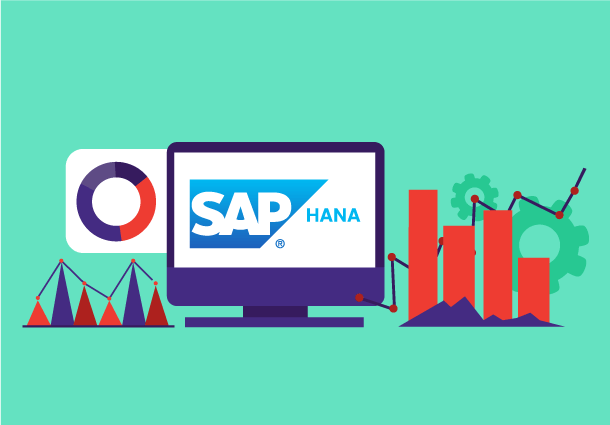SAP HANA: The Quantum Leap in Data Management and Analytical Proficiency
In the heart of the tech kingdom, where innovation danced through the air like confetti at a carnival, SAP HANA showed up on the scene with all the panache of a circus ringmaster. An innovative in-memory database platform called SAP HANA was conceived out of a strategic drive by the German software giant SAP AG. Determined to meet the rising requirements for real-time data processing and analytics, HANA’s development began in the 2000s. SAP saw the need to switch from conventional disk-based databases to a viable in-memory strategy. HANA was intended to give organizations the capacity to deal with huge amounts of data at breakneck speeds, conveying speedy experiences and reforming the way they make choices. The SAP HANA architecture was officially disclosed by SAP in 2010, which was a basic defining moment for corporate software. The quick data processing made conceivable by HANA’s in-memory technology permits organizations to direct modern queries and analyses progressively.
HANA was intended to give organizations the capacity to deal with huge amounts of data at breakneck speeds, conveying speedy experiences and reforming the way they make choices. The SAP HANA architecture was officially disclosed by SAP in 2010, which was a basic defining moment for corporate software. The quick data processing made conceivable by HANA’s in-memory technology permits organizations to direct modern queries and analyses progressively.
Hence began SAP HANA’s experience, a story brimming with surprises as it set off on a mission to change the regular field of database administration into something exceptional. It acquired abilities to astonish along the road, including the ability to analyze colossal volumes of data in a brief moment, providing organizations with the endowment of real-time insights. We’ll enlarge this fascinating tale of invention as it develops. We’ll look at how SAP HANA developed from a theoretical idea into a disruptive force in the world of business software. Prepare to set off on a mystical journey across reality where the commonplace becomes exceptional and information is transformed into pure enchantment!
SAP HANA Architecture: The Data Alchemist’s Design
The architecture of SAP HANA is a mesmerizing technical orchestra that coordinates several parts to produce a fast, in-memory database platform. Think of it as a large orchestra where each instrument is fundamental to delivering a phenomenal performance. The in-memory database, which stores and maintains data totally in RAM, fills in as the underpinning of the SAP HANA architecture. This implies that fast, easy access to data dispenses with the requirement for arduous disk-based retrieval. It’s like having a magical library where, upon thought, any book might be found. The directors of this orchestra are the SQL (Structured Query Language) and MDX (Multidimensional Expressions) engines, which precisely decipher guidelines and queries. Like a carefully prepared maestro directing a flawless concert, they guarantee that you receive a prompt and precise response when you pose an inquiry. The Calculation Engine, which handles intricate computations and aggregations, is another vital part. The XS Engine is a part of the SAP HANA architecture that empowers developers to make applications directly on the platform.
At the point when there are technical challenges or unforeseeable fiascos, the performance nevertheless goes on because of high availability (HA) and disaster recovery (DR) procedures. They act as the performance’s security nets and keep everything along easily. The design likewise upholds multi-tenancy, permitting various applications to coincide peacefully on a similar HANA instance. This looks like having numerous craftsmen perform on a similar stage while smoothly switching between them. The HANA database architecture basically joins speed, exactness, and versatility in a consistent way. It is an engineering marvel that transforms data handling into an ensemble of viability, making it a champion among business databases.
The Retail Resonance: SAP HANA’s E-commerce Triumph
The way that organizations run their online stores is changing because of SAP HANA’s development as a disruptive power in the fast-paced world of e-commerce, where every second matters and client expectations are soaring. SAP HANA colossally affects e-commerce websites and its importance is still flourishing. The strength of SAP HANA lives in its capacity to handle data in memory at fantastic rates, permitting e-commerce platforms to give first class user experiences. This outcome in product pages loading immediately, keeping expected customers from being kept waiting, and bringing down bounce rates. Real-time analytics also empower e-commerce enterprises to grasp client behavior, empowering customized product suggestions and marketing plans. The limit of HANA database architecture to oversee tremendous measures of data in an effective way is one of its most impressive features. This involves maintaining huge client databases, transaction histories, and product catalogs with ease in e-commerce. Advanced analytics can utilize this plenty of data, empowering e-commerce companies to make data-driven choices, optimize supply chains, and predict demand with accuracy.
keeping expected customers from being kept waiting, and bringing down bounce rates. Real-time analytics also empower e-commerce enterprises to grasp client behavior, empowering customized product suggestions and marketing plans. The limit of HANA database architecture to oversee tremendous measures of data in an effective way is one of its most impressive features. This involves maintaining huge client databases, transaction histories, and product catalogs with ease in e-commerce. Advanced analytics can utilize this plenty of data, empowering e-commerce companies to make data-driven choices, optimize supply chains, and predict demand with accuracy.
The capacities of sap hana database architecture sparkle in the space of inventory management. It offers real-time stock level tracking, ensuring that e-commerce websites can precisely enlighten clients concerning the accessibility of products. Alongside developing customer pleasure, this likewise makes the order fulfillment process more productive, bringing down expenses and mistakes. Moreover, SAP HANA’s cutting-edge security capacities are fundamental for safeguarding sensitive client data, particularly in when cybersecurity is extremely vital. Because of its strong authentication and encryption systems, e-commerce websites can consent to severe data security regulations while offering customers a safe purchasing experience.
SAP HANA vs SAP HANA Studio: The Confluence of Data Pioneers
With regards to boosting the capability of in-memory computing for endeavors, SAP HANA and SAP HANA Studio are two closely connected but separate components of the SAP HANA ecosystem. Let’s look at these two components to illuminate their individual capabilities and importance. On a very basic level, SAP HANA is an in-memory database technology that transforms data analysis and processing. It utilizes cutting-edge technology to rapidly store and recover data, making it an invaluable resource for organizations searching for real-time insights. The main impetus behind data-driven decision-making,, SAP HANA empowers organizations to examine colossal datasets with bewildering productivity. It acts as the driving force of a large machine, generating colossal force.
The particular development and management environment for SAP HANA is called SAP HANA Studio. It fills in as the regulatory center point where directors and engineers can make due, set up, and further develop their SAP HANA frameworks. Envision it as the cockpit of an advanced airplane, where knowledgeable personnel ensure that all frameworks are running productively. A full set of tools is presented by SAP HANA Studio for execution monitoring, establishing data models, and developing data-intensive applications that are fit to specific business prerequisites. Basically, SAP HANA Studio is the garrison, the cockpit where experts direct and manage the system’s operations, whilst SAP HANA is the backbone, the engine room, of this data processing miracle. They cooperate agreeably, with SAP HANA providing the blazing speed and power required for data operations, and SAP HANA Studio offering the tools and interfaces vital for successful management and utilization.
The Enchanted Cloudscape: SAP HANA’s Frontier Expedition
The move of SAP HANA to the cloud, including platforms like Azure, AWS, and GCP, significantly affects corporate computing. This move towards cloud-based SAP HANA installations has opened up an entirely different universe of opportunities for organizations searching for adaptability, versatility, and cost-effectiveness in dealing with their data and analytics prerequisites. Microsoft’s cloud platform, SAP HANA on Azure, consolidates the modern usefulness of SAP’s in-memory database with Azure’s worldwide adaptability and framework. Through this mix, organizations can utilize Azure’s vast network of data centers while utilizing the abilities of SAP HANA. Rapid deployment, scalability, and flexibility are the end results, empowering firms to acclimate to shifting data needs.
Through this mix, organizations can utilize Azure’s vast network of data centers while utilizing the abilities of SAP HANA. Rapid deployment, scalability, and flexibility are the end results, empowering firms to acclimate to shifting data needs.
The Amazon Web Services offering SAP HANA on AWS offers a cloud-native environment for operating SAP HANA workloads. AWS offers a reliable and secure basis for SAP HANA operations with its wide scope of services and global network of data centers. Through this cooperation, organizations can utilize AWS’s data analytics, machine learning, and storage capabilities, increasing SAP HANA’s entire value offer. The upsides of SAP HANA in a GCP-powered environment are conveyed by SAP HANA on GCP for associations with an inclination for Google Cloud Platform (GCP). The abilities of SAP HANA are improved by GCP’s aptitude in data analytics and machine learning, opening up opportunities for cutting edge analytics and innovation. The overall GCP network ensures low-latency data access, significantly upgrading SAP HANA’s performance. The advantages of SAP HANA on the cloud go beyond its performance and adaptability. Furthermore, it simplifies infrastructure administration, which decreases the responsibility on IT workers. Cloud organizations additionally give solid security shields and compliance certifications, addressing worries about data security and legal obligations.
Leveraging the Synergy: Empowering Insights with Power BI and SAP HANA
Microsoft Power BI and SAP HANA’s integration makes a strong collaboration that empowers organizations to benefit from their data assets. An elite exhibition database and data processing platform is given by SAP HANA, which is perceived for its in-memory computing capacities. It really organizes and saves huge databases, considering data retrieval and sophisticated analyses. Then again, Microsoft’s Power BI is a strong business analytics product known for its user-friendly interface and visualization capabilities. Users can fabricate dynamic and stylishly engaging reports and dashboards when Power BI and SAP HANA are joined. Through this reconciliation, the gap between unprocessed data and practical insights is closed. Users may effortlessly get to SAP HANA data with Power BI, transforming complicated datasets into understandable information. For businesses hoping to capitalize on their SAP HANA investments, this partnership is as yet a pivotal resource. It’s prescribed to stay aware of the latest innovations in both SAP HANA and Power BI as the technological environment changes, since they frequently roll out improvements and features to further fortify this partnership.
Navigating Digital Waters with Pattem Digital: Your Trusted Navigator
Our organization succeeds in giving cutting-edge solutions that advance corporate achievement, making it the top choice for SAP HANA services. We give unequaled knowledge in SAP HANA implementation, optimisation, and support. Our commitment to keeping at the bleeding edge of SAP HANA developments ensures that our clients get to take advantage of the newest developments and industry best practices. Trust us to utilize SAP HANA to transform your data into useful insights that will grow your company.


